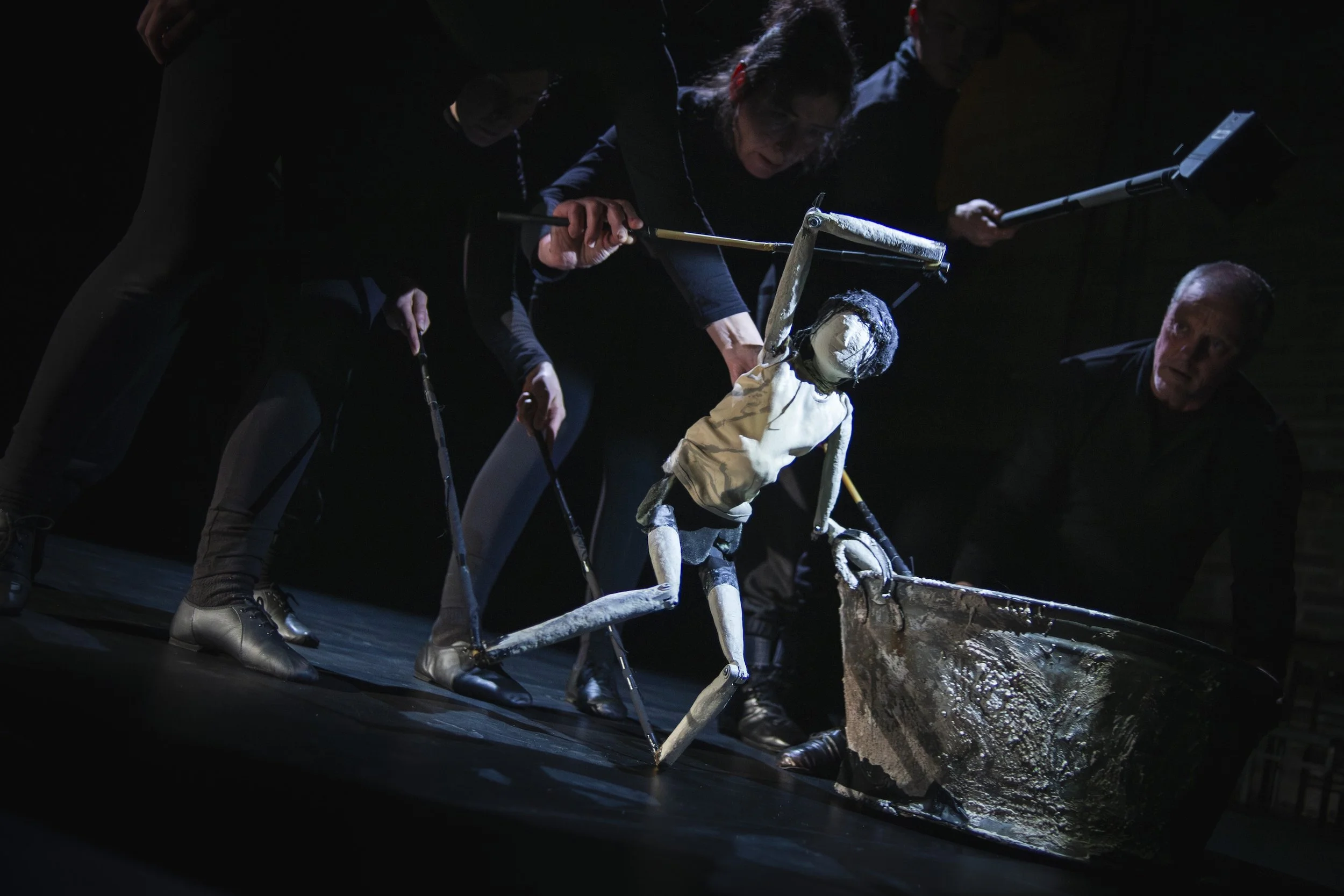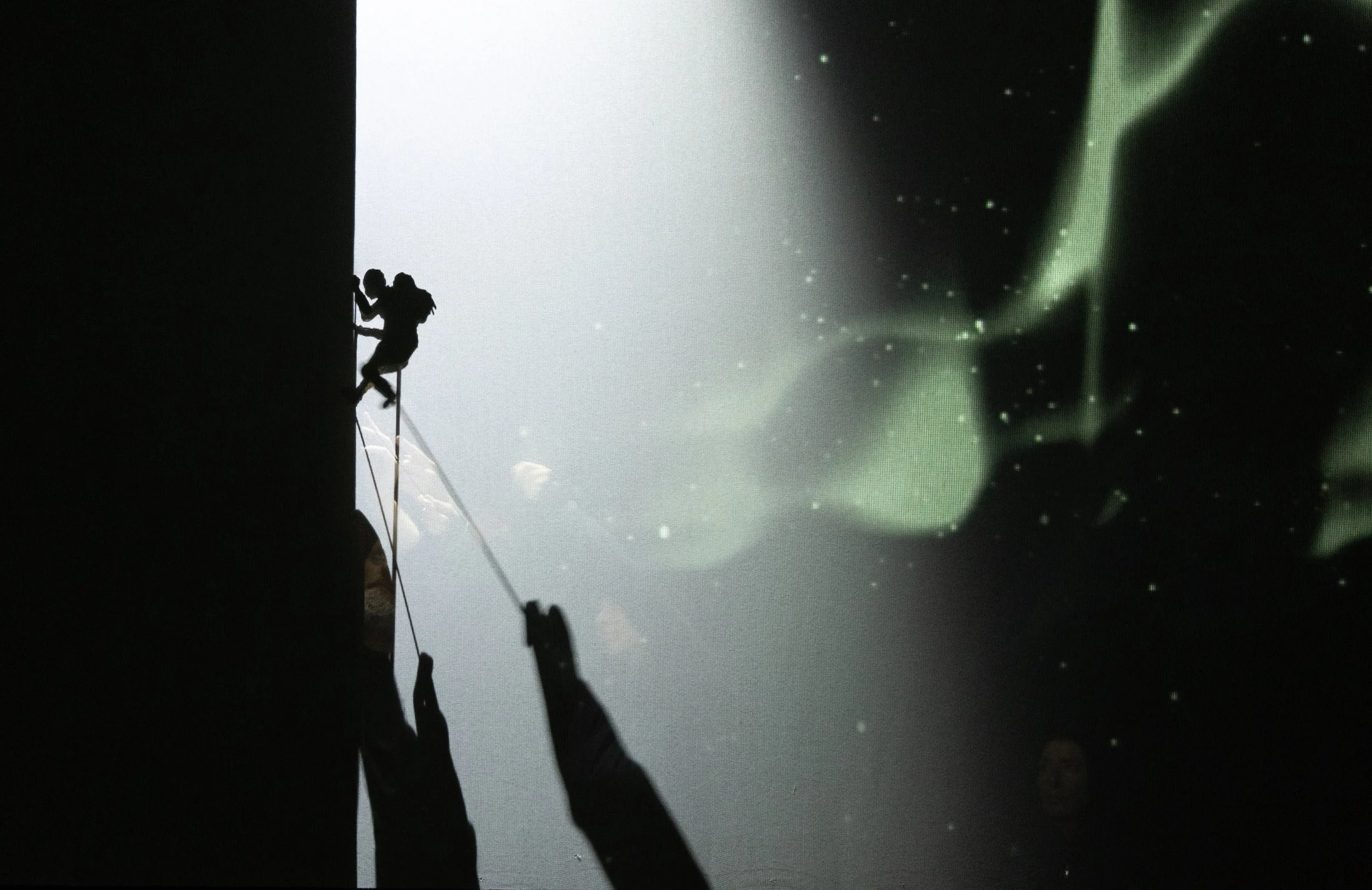the last pearl :: programme
Photo by Peter Martin
Directed by Niall Henry
Dramaturg Jocelyn Clarke
CAST
John Carty
Sandra O Malley
Brian F Devaney
Aine Ní Laoghaire
Aisling Mannion
Set Design Jamie Vartan
Sound Design Joe Hunt
Lighting Design Barry McKinney
Lighting Technician Emily Waters
Set Construction Alan Clarke
Production Maurice Power
Production Assistant Francis Hegarty
The Last Pearl is the fourth in a series of devised works since 2016 that include Shackleton, The School Days of Thaddeus K and Hunting Darwin.
Loosely based on the ideas of environmentalist James Lovelock, The Last Pearl tells the story of M, a pearl diver, in her search to survive in an ever-changing and increasingly challenging world.




James Lovelock
James Lovelock (26 July 1919 – 26 July 2022) was an English independent scientist, environmentalist and futurist. He is best known for proposing the Gaia hypothesis, which postulates that the Earth functions as a self-regulating system.
He was an outspoken member of Environmentalists for Nuclear Energy, asserting that fossil fuel interests have been behind opposition to nuclear energy, citing the effects of carbon dioxide as harmful to the environment and warning of global warming due to the greenhouse effect.
“One thing that being a scientist has taught me is that you can never be certain about anything. You never know the truth. You can only approach it and hope to get a bit nearer to it each time. You iterate towards the truth. You don't know it.” JL
Theatre Academy 2025
Blue Raincoat Theatre Academy provides multi-disciplinary training for all artists and performers and will host a series of workshops and events throughout 2025:
Wednesday 12th - Saturday 15th March 2025
Corporeal Mime Training with Corinne Soum, former assistant of Etienne Decroux and Co-founder of Theatre de L’Ange Fou.Saturday 14th & Sunday 15th June 2025
Voice Training with David Goldsworthy & Marianne Le Tron, senior tutors of the Roy Hart International Voice CentreWednesday 18th - Saturday 21st June 2025
Anne Bogart Workshop: Embodied Problem Solving
Anne Bogart
Hunting Darwin
(shadow puppetry)
Monday 4th - Saturday 9th of August | 8pm
The Factory Performance Space
Hunting Darwin is based on an event during Scott’s second attempt to reach the South pole.
Henry Bowers, Apsley Cherry-Garrard and Bill Wilson took 35 days to collect three emperor penguin eggs in July 1911. In the middle of the Antarctic winter, they had to survive intense blizzards and temperatures that plunged to –60C. It was pitch black and the three had to navigate by candlelight and the stars. They took turns falling into crevasses. Cherry's teeth chattered so violently that they shattered, while Wilson was blinded in one eye by a blob of boiling blubber from a camp stove.
In the end, the three men – members of Robert Scott's doomed expedition to the south pole – returned to their base camp, utterly exhausted and close to death, with the three penguin eggs packed in their sleds. Cherry never recovered from the ordeal – which he vividly described in his book, The Worst Journey in the World – while Wilson and Bowers died with Scott on his final trek back from the pole.
The eggs were supposed to reveal the evolutionary links between reptiles and birds but their collection nearly killed the journey's participants. They remain some of the most precious ornithological specimens on the planet.
At the time of the winter trip, it was thought the emperor penguin was one of the planet's most primitive birds and that analysis of its embryos would reveal links between all birds and their reptile predecessors. However, the emperor penguin lays its eggs in June, in the Antarctic midwinter, hence the decision to make the 70-mile trip from Scott's base camp on Ross Island to the penguin colony at Cape Crozier during the worst possible weather. Scott was initially opposed to the plan, but was convinced by Wilson, the trip's zoologist, to go ahead because he thought the eggs would play a key role in understanding how species evolve.
So, at midday on 27 June 1911, Cherry, Bowers and Wilson, with two sleds of food and equipment, left base camp and trudged into a freezing, pitch-black, gale-battered nightmare. The thick, cloying snow meant they could only pull one sled at time. So they had to proceed in relay, gaining only one mile for every three they walked. The average temperature for the trip was –40C. The impact on the men was horrific, as Cherry's biographer, Sara Wheeler, notes. "It took him 45 minutes to chip his way into his sleeping bag each night, as during the day it froze flat like a slab of tombstone granite."
Then, as they reached their target, their tent blew away and the men lay down to die. For two days they lay in their sleeping bags without food or cover until there was a lull in the blizzard and Bowers found their tent. "Our lives had been taken away and given back to us," Cherry wrote.
They reached the emperor penguin colony by climbing the huge walls of ice that surrounded it and they snatched five eggs. Cherry dropped two, but the others were returned to the team's sleds. The three staggered into base camp on 1 August 1911. Their frozen clothes had to be cut from their bodies. "Cherry looked about 30 years older than he had when he had set off, his cadaverous face scarred and corrugated, nose dark, eyes dull and hands white and wrinkled. His toenails were falling off and his fingers were useless," Wheeler notes.
Cherry, who had no scientific training, took responsibility for the eggs and presented them to the Natural History Museum in 1913. At first a junior assistant refused to take the specimens. Then a senior member of staff made him wait in a corridor while he talked to a more important person. Eventually Cherry extracted a receipt. "I handed over the Cape Crozier embryos, which nearly cost three men their lives and cost one man his health, to your museum personally and … your representative never even said thanks," Cherry later wrote to the museum.
It became one of the infamous moments in museum history. In fact, another 21 years would pass before the eggs were studied and the results published. Their first recipient, Richard Asherton, of Cambridge University, had the embryos removed from the shells and slides made from them but died before he could analyse them.
The eggs were then kept in storage while occasional scientists were asked to study them. Eventually, in 1934, the zoologist CW Parsons analysed them and concluded that "they did not greatly add to our understanding of penguin embryology". For good measure, scientists no longer believe that embryos help much in studying a species' evolutionary history.
However, the specimens were used in a later study of emperor penguins and were reckoned to be useful. "Ultimately, though, they did not provide the information that was hoped for them. On the other hand, they are still here for more study and reinterpretation. In that sense, they are invaluable."
Hunting Darwin photographs by Peter Martin
Bill Wilson, Henry Bowers and Apsley Cherry-Garrard pictured as they set off on their mission to Cape Crozier. Photograph: Popperfoto/Getty
The Company
Blue Raincoat Theatre Company was founded by Fionnuala Gallagher, John Carty, Malcolm Hamilton and Niall Henry in the Autumn of 1990.
We are a venue-based theatre ensemble producing a programme of professional productions each year, with an emphasis on devising new work and staging modern European classics. The company employs a repertory system touring some of these productions throughout Ireland and internationally.
Blue Raincoat also provides a broad range of professional arts related support for community and cultural programming within our immediate region.
See blueraincoat.com for more info








